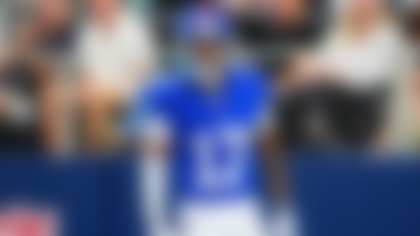Josh Gordon is back from suspension after being reinstated by the NFL on a conditional basis. How long the talented but troubled New England Patriots receiver will remain active is undoubtedly one of the first questions that comes to mind, as he's been suspended four times for violating the league's substance abuse policy since 2013.
"We are all rooting for Josh to succeed, both personally and professionally," NFL Commissioner Goodell said in a statement on Friday. "Everyone shares in that hope and will continue to support him to every extent possible. But as Josh acknowledged, ultimately his success is up to him."
It's not yet clear when Gordon will be cleared to practice -- his participation is subject to appropriate progress on clinical care and other arrangements -- although I did see him back at the team facility on Monday. Head coach Bill Belichick was tight-lipped when asked about Gordon during his press conference earlier in the day, pointing reporters to his 37-word statement from Saturday.
For now, let's put the focus on how Gordon changed the Patriots' offense after being acquired from the Cleveland Browns in mid-September last season. The difference in New England's offensive output with and without Gordon, who played for the Patriots from Weeks 4-15, is a reminder of just how gifted the 28-year-old is. The Pats' production was better when Gordon was active, as they threw for slightly more than 60 yards per game and scored 2.5 points more per contest. Gordon's 18 yards per catch placed him second in the entire league, trailing only then-Bucs receiver DeSean Jackson (now with the Eagles). And Tom Brady averaged 11.3 yards per attempt to Gordon, which is the best mark of any Brady-to-receiver combo since 2006, according to Pro Football Focus. The sample size is small, but that's better than Brady to Randy Moss (9.2) and Brady to Rob Gronkowski (10.3).
Gordon's insertion into the lineup wasn't an instant success, though -- he averaged just three catches for 41.3 yards through his first three games -- and it took some trial and error to figure out what worked best between he and Brady. For instance, Brady had a completion rate of 50 percent or less when targeting Gordon on go, back-shoulder, post, out and corner routes, per PFF. He was just 2-of-7 on the back-shoulder routes and 2-of-5 on the go routes, although two of Gordon's four touchdowns did come via those routes.
Gordon had two 100-yard games (100 yards against the Bears, 130 against the Packers) but the line of delineation for this observer came on Nov. 11 in a loss at Tennessee. Brady targeted Gordon a season-high 12 times, completing just four of the throws. Many were tossed up on a wing and a prayer, highlighting the difficulties in getting the ball to the wideout deeper down the field.
But post-Tennessee -- and with the benefit of the bye week that followed the loss -- the efficiency of the Brady-to-Gordon connection really shined through. Brady targeted Gordon 17 times in a three-game stretch against the Jets, Vikings and Dolphins, connecting on 13 of those throws for 226 yards and a touchdown. Much of Gordon's production came courtesy of slants and in-routes, which highlight the wideout's massive 6-foot-3, 225-pound frame and willingness to play physically. With New England combining Gordon's size with Brady's accuracy, the opposition's smaller, lighter defensive backs often found themselves in situations where they couldn't win, unable to go through Gordon or to work around him. The numbers don't lie: Brady was 11-of-15 for 145 yards when targeting Gordon on slants, and 8-of-9 for 198 yards and a TD on in-routes.
By then, though, the peak of Gordon's 2018 campaign was already behind him. His final game last season was a quiet showing against the Steelers (one catch for 19 yards), and the wide receiver disappeared from the scene the following week, once again overrun by his off-field issues. The Pats' offense had to morph in his absence and it obviously turned out well for them -- hello, Super Bowl win -- but you could see the imprint Gordon left on the team when it drafted another hulking pass catcher, former Arizona State WR N'Keal Harry, in the first round this year. That marked the first time the Pats spent a first-rounder on a wide receiver in the Belichick era, and at 6-4, 225 pounds, Harry is nearly a carbon copy of Gordon from a size perspective. Plus, Harry enters the league with a reputation as a terrific contested-catch maker, much like Gordon himself. New England also signed Demaryius Thomas in April, another big receiver at 6-3, 225 pounds. As of today, that makes the Patriots the only team in the league with three wide receivers that weigh 225 pounds or more, a shift from their normal approach at the position. Of course, there is only one Gordon, and the Pats are now seeing Flash in the flesh, which has to be a welcome sight for a team that has a chance to overpower defenses with the size of its pass catchers, even after losing Gronk to retirement in the offseason.
Follow Mike Giardi on Twitter @MikeGiardi.












